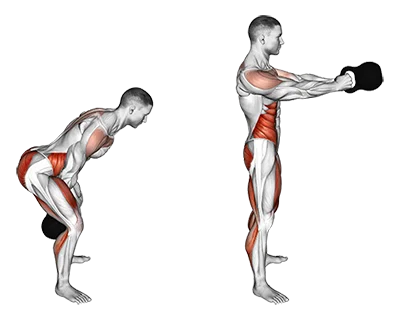Introduction
The Kettlebell Swing is a dynamic exercise that involves swinging a kettlebell back and forth between the legs and up to shoulder level. This movement primarily targets the glutes, hamstrings, and core muscles, improving lower body strength, power, and endurance. Effective for various fitness goals, such as weight loss, functional training, and athletic performance enhancement, due to its full-body engagement, high calorie burn, and versatility in intensity and repetitions.
Muscles Worked
- Primary: Lower Back, Glutes, Hamstrings, Core
- Secondary: Shoulders, Forearms, Lats (Latissimus Dorsi), Quads (Quadriceps)
How to Do It (Step-by-Step)
- Stand with feet hip-width apart, toes pointed slightly outwards, a kettlebell in front of you between your feet. Bend at the hips and knees to hinge at the waist while keeping your back straight, holding the kettlebell handle with both hands. The kettlebell should be directly between your legs and slightly behind them.
- Swing the kettlebell backward between your legs, then thrust your hips forward forcefully to propel the kettlebell upwards in a vertical arc. Let gravity bring the kettlebell back down while you bend at the knees, then repeat.
- Keep your back straight and core engaged throughout the movement; use only hip hinge and not overuse arms. Swing the kettlebell with control, avoiding jerking or swinging it too high. Ensure that the kettlebell passes just below knee level on each rep.
Tip: Maintain a soft bend in your knees to absorb the impact of the kettlebell and protect your back.
Rep & Rest Guidelines
- Strength: 4–6 reps, 2–3 min rest
- Hypertrophy: 8–12 reps, 60–90 sec rest
- Endurance: 12–20 reps, 30–60 sec rest
Training effectively with Auto Progression and tracking rest intervals using the Rest Timer.
Form Tips
- Maintain a flat back throughout the movement: Keep your lower back naturally arched and avoid rounding or excessively arching it. This ensures safety and maximizes the power transfer in each swing.
- Hinge at the hips, not bend at the waist: As you initiate the swing, push your hips backward while keeping your knees slightly bent. This movement should come from your hips, not your back or waist.
- Use your entire body to generate force: Swing the kettlebell by using a combination of hip hinge, glute and hamstring engagement, and an explosive contraction of your core muscles. Aim for a powerful, fluid motion rather than relying on arm strength alone.
When to Use It
- For high-intensity cardiovascular exercises that build power and strength in the lower body
- As a part of functional fitness training routines focusing on core and hip engagement
- Effective for metabolic conditioning workouts to burn calories and improve endurance
Workout History keeps track of your progress over time.
The kettlebell swing primarily works the hamstrings, glutes, lower back, and core.
Aim for 3-5 sets with 8-12 repetitions per set for a full body workout.
Stand with feet hip-width apart, bend knees slightly, hinge at hips, and keep back flat while swinging the kettlebell between legs and overhead.
It's generally not recommended to perform kettlebell swings every day due to the potential for overuse injuries. Allow rest days for recovery.
Start with a lighter weight (e.g., 10-16kg/22-35lbs) to build proper form, then gradually increase the weight as you become stronger and more experienced.

